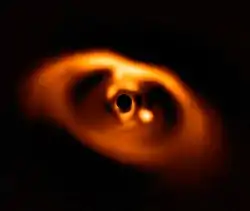Sub-Neptune
The term sub-Neptune can refer to a planet with smaller radius than Neptune even though it may have a larger mass[1] or to a planet with a smaller mass than Neptune even though it may have a larger radius like a super-puff and both meanings can even be used in the same publication.[2]
Neptune like planets are considerably rarer than sub-Neptune sized planets, despite being only slightly bigger.[3][4] This “radius cliff” separates sub-Neptunes (radii < 3 Earth radii) from Neptunes (radii > 3 Earth radii).[3] This radius-cliff is thought to arise because during formation when gas is accreting, the atmospheres of planets that size reach the pressures required to force the hydrogen into the magma ocean stalling radius growth. Then, once the magma ocean saturates, radius growth can continue. However, planets that have enough gas to reach saturation are much rarer, because they require much more gas.[3]
References
- Detection and characterization of an ultra-dense sub-Neptune planet orbiting the Sun-like star HD 119130, R. Luque et al, 21 Dec 2018
- Tidally-Induced Radius Inflation of Sub-Neptunes, Sarah Millholland, 17 Oct 2019
- https://astrobites.org/2019/12/17/why-are-there-so-many-sub-neptune-exoplanets/
- Superabundance of Exoplanet Sub-Neptunes Explained by Fugacity Crisis, Edwin S. Kite, Bruce Fegley Jr., Laura Schaefer, Eric B. Ford, 5 Dec 2019
